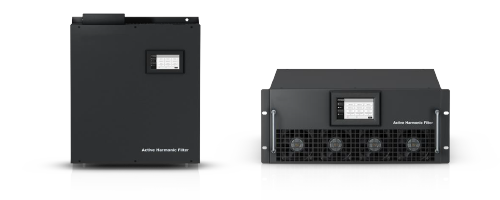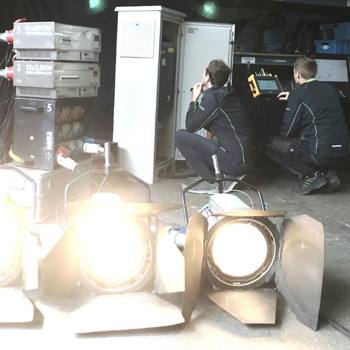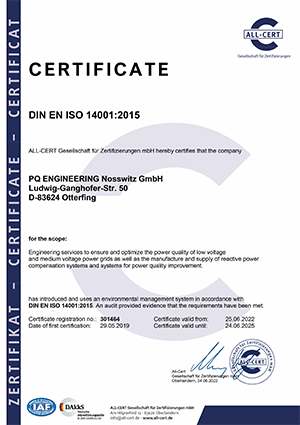Case study: AHF in generator grids
Our new case study shows how generator networks with modern loads can be improved by using an AHF (Active Harmonic Filter).
Voltage quality in generator grids – Always a challenge!
Mobile generators provide electrical power in the film and event industry and also in emergency operations. Today, devices with a non-linear current consumption are increasingly connected to these generators. This leads to unbalanced loading and a strong distortion of the voltage. The genset, diesel engine and generator start “pumping” and become overloaded. Here, an active filter AHF (Active Harmonic Filter) provides a remedy and optimizes the load. A test scenario with real loads at Sparks Filmtechnik GmbH in Munich confirms the positive effects.
Task
Compared to normal grids with transformer feed-in, generator networks have an internal resistance that is higher by a factor of about 3. As a result, the operation of loads with non-linear load characteristics leads to much higher voltage distortions at the generator terminals. Figure 1 shows the waveforms of the voltages and currents in a generator network. The generator has a rated power of 100 kVA. It is loaded with electronic dimmers and switching power supplies that have a total power of 40 kVA. The uneven connection of the mostly single-phase equipment on the three phases results in a highly unbalanced load on the generator. This is shown in the right part of the “RMS current” diagram in Figure 2. The unbalance results in a neutral current (blue) that loads the lines and the generator star point.
The clearly visible voltage distortions increase the risk of destruction of sensitive loads, there is a mechanical load on the power unit and a thermal overload of the stator windings. These negative effects are often countered by the deliberate selection of an oversized generator.

Figure 1 Waveform of voltage (top) and current (bottom) without AHF
The network analysis showed that the current consumption of the luminaires for normal operation and battery operation differed greatly. While in normal operation the actual load current is shown, in inverter operation a massive superposition of the resonance current is added. The supply voltage was so distorted that the inverter did not operate stably. As the power quality measurement showed, the resonance point shifts with the connection of each luminaire. As soon as eight luminaires are powered by the battery network, a significant harmonic current flows, which heats up the circuit breakers and thus promotes premature tripping.

Figure 2 RMS voltage (top) and rms current (bottom)
Solution
In the past, mainly passive harmonic filters were available for filtering voltage distortions. These so-called filter circuits are constructed as a series circuit of chokes and capacitors. In order to achieve a sufficient filter effect, a considerable amount of capacitive reactive power is accepted. But generator networks in particular should not be operated in the capacitive range. The reason is illustrated in Figure 3. For example, with a cos = 0.6 capacitive, only 40 % of the generator rated power can be interrogated. At higher loads, the maximum possible torque is reduced while the terminal voltage is dangerously increased. Therefore, the loads connected to a generator should be in the optimal operating range of the generator with a displacement factor cos between 0.95 capacitive and 0.8 inductive.

Figure 3 Maximum permissible power of a generator as a function of cos φ
Today, active filters are available with power electronics that do not load the generator with capacitive reactive power, but rather can fully compensate for the consumer reactive power. These AHFs are connected in parallel with the devices and eliminate their feedback with a response time of less than one millisecond. AHFs are universal trouble-shooters in the power supply network and can be
These electronic “load optimizers” are offered by PQ ENGINEERING with different filter currents from 15 A to 300 A and in various designs, as wall-mounted unit AHF-W, as plug-in module AHF-R for rack mounting or as floor-standing unit AHF-C in outdoor housings. Especially the outdoor installation simplifies the use for temporary installations and events.

Figure 4 Test scenario with AHF-C-100 in outdoor housing
Benefits
By using an active filter AHF, the frequently chosen overdimensioning of the unit can be dispensed with. With the network adjustment of the AHF, one achieves the following advantages:
And this is how the same generator network looks when operated with an AHF: A much cleaner voltage with symmetrical, sinusoidal current consumption compared to Figure 1.

Figure 5 Waveform of voltage (top) and current (bottom) with AHF

Figure 6 AHF-W active filter for wall mounting and AHF-R for rack mounting
PQ ENGINEERING thanks for providing the test location and equipment to:

“By using the AHF, we offer
our customers added value and
at the same time protect our plants from
Overload.
A real win-win situation!”
Ralf Hauschild
Managing Director
Sparks Film Technology Ltd.










